Information systems cannot deliver value from the first day in an organization. The organization needs time and maturity to be able to leverage the information system. Various organizations are at different levels of maturity in dealing with information systems. Nolan has provided a model for such information systems using maturity in organizations. However, empirical evidence is not available in favor of such models but intuitively, it seems correct. To leverage the benefits of information, an organization has to first appreciate the usefulness of information. This requires a change in the mindset and way of working. Organization culture needs to change to accommodate this kind of information-based working. Changing organizations takes time and hence, organizations pass through stages of maturity in dealing with information systems.
Nolan’s Six-stage Model
One of the stages of growth model, helping in the understanding of the role of information systems, in an organization’s strategy and its maturity. Earlier, in a similar model called the four-stage growth model the maturity of an organization was captured in terms of use of information systems. The stages are,
- Initiation-in which the primary focus is cost reduction and only specialized applications are run with a specialized staff. Management in not very keen on monitoring the information system.
- Expansion-in which application increase rapidly. Specialization of staff and applications is the order of the day. Management begins to take note of the new way of doing things.
- Formalization-in which emphasis is laid on control and specialization, is built around control. Management controls information systems.
- Maturity-in which database oriented applications proliferate. Information is used as a resource.
Nolan’s Stages of Growth Model
I | II | III | IV | V | VI |
INITIATIONS • Users are “hands off” in approach • Extensive IT/IS planning • Cost reduction primary focus • Functional application is in focus • MIS dept/IS dept is not under strict management control | CONTAGION • Proliferation of applications • Little management control • Huge allocation of financial resources • Rapid growth of fundamental use of IT • IS/IT performance below importation and several crisis occur | CONTROL • IT/IS is considered as an important function • Centralized controls are applied for IT/IS • No reduction in IT/IS use • Applications are often incompatible • Unhappy users • Use of database but with unsatisfactory outcome | INTEGRATION • Greater use of database • Greater IT/IS budget • IT/IS dept now works on a professional utility model • Formal planning and control within IT/IS dept • Steering committees are widely used for application development. | DATA ADMIN • Data in administration • Applications are in sync with the organization • Shift from IT/IS booking after DP to holistic information management | MATURITY • IT/IS dept becomes partners of users in data management • Applications reflect real information needs • Strategic planning of IT/IS becomes important • Managers of IT/IS dept considered at par with other dept |
Nolan (1979) indicated that there are six stages in the information system evolutionary process. It is an improvement over the four-stage model. The stages are:
- Initiation- in which the organization has an operational focus and tries to get operational efficiency and thereby limited value from the information systems.
- Contagion-in which the organization moves towards online systems after having tasted success in the initiation stage. More users are added.
- Control-in which the management exercises control and makes a cost-benefit type of assessment.
- Integration-in which the organization moves away from an ad hoc isolated solutions based on information system to a service based information system. This is the stage when the organization transitions from a data processing outlook about information systems to more holistic information-based decision-making approach towards information systems. A more comprehensive approach towards information systems results in changes in the organization’s behavior towards information systems and initiates a new appreciation for data and information.
- Data administration-in which the organization begins to appreciate the value of information and makes efforts to centralize the data management to take advantage of the benefits of information based decision-making.
- Maturity-in which the organization creates synergies in its corporate objectives and information systems planning so that the two can work in a synchronized manner.
These are the stages as Nolan has described in this research. However, no empirical proof exists of this stage growth model of information system maturity.

 Dinesh Thakur holds an B.C.A, MCDBA, MCSD certifications. Dinesh authors the hugely popular
Dinesh Thakur holds an B.C.A, MCDBA, MCSD certifications. Dinesh authors the hugely popular